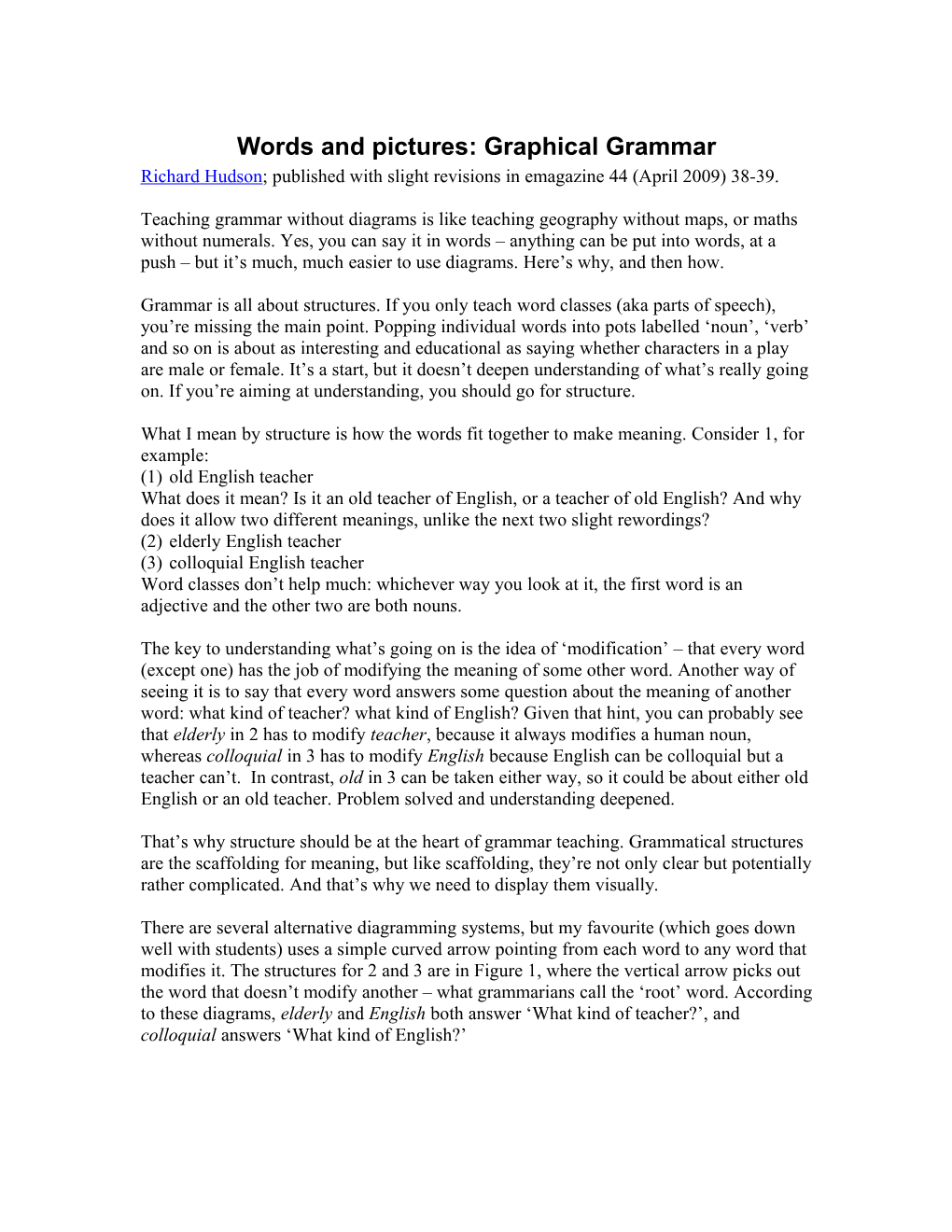Words and pictures: Graphical Grammar
Richard Hudson; published with slight revisions in emagazine 44 (April 2009) 38-39.
Teaching grammar without diagrams is like teaching geography without maps, or maths without numerals. Yes, you can say it in words – anything can be put into words, at a push – but it’s much, much easier to use diagrams. Here’s why, and then how.
Grammar is all about structures. If you only teach word classes (aka parts of speech), you’re missing the main point. Popping individual words into pots labelled ‘noun’, ‘verb’ and so on is about as interesting and educational as saying whether characters in a play are male or female. It’s a start, but it doesn’t deepen understanding of what’s really going on. If you’re aiming at understanding, you should go for structure.
What I mean by structure is how the words fit together to make meaning. Consider(1), for example:
(1) old English teacher
What does it mean? Is it an old teacher of English, or a teacher of old English? And why does it allow two different meanings, unlike the next two slight rewordings?
(2) elderly English teacher
(3) colloquial English teacher
Word classes don’t help much: whichever way you look at it, the first word is an adjective and the other two are both nouns.
The key to understandingwhat’s going on is the idea of ‘modification’ – that every word (except one) has the job of modifying the meaning of some other word. Another way of seeing it is to say that every word answers some question about the meaning of another word: what kind of teacher? what kind of English? Given that hint, you can probably see that elderly in (2) has to modify teacher, because it always modifies a human noun, whereas colloquial in (3) has to modify English because English can be colloquial but a teacher can’t. In contrast, old in (3) can be taken either way, so it could be about either old English or an old teacher. Problem solved and understanding deepened.
That’s why structure should be at the heart of grammar teaching. Grammatical structures are the scaffolding for meaning, but like scaffolding, they’re not only clear but potentially rather complicated. And that’s why we need todisplay them visually.
There are several alternative diagramming systems, but my favourite (which goes down well with students) uses a simple curved arrow pointing from each word to any word that modifies it. The structures for (2) and (3) are in Figure 1, where the vertical arrow picks out the word that doesn’t modify another – what grammarians call the ‘root’ word. According to these diagrams, elderly and English both answer ‘What kind of teacher?’, and colloquial answers ‘What kind of English?’
Figure 1
Now let’s raise the stakes with a nice test of grammatical imagination due to Groucho Marx:
(4) Time flies like an arrow; fruit flies like a banana.
Why does this simple sentence make your brain hurt? We’ll start by looking at the first clause on its own, in its most obvious meaning where it’s about flying. What flies how? Time flies like what? Like an arrow. The grammatical structure is as shown in Figure 2. I’ve left an out of the analysis because it raises problems that aren’t relevant here.
Figure 2
The second clause has a completely different meaning and structure. It’s not about flying at all, but about liking. What likes what? Flies like a banana. What kind of flies? Fruit flies.Figure 3 shows the structure.
Figure 3
Groucho’s joke turns on the structural difference between the two clauses. The obvious meaning of the first clause demands one structure, but then the equally obvious meaning of the second clause demands a different structure for almost the same sequence of words.
The effect is just like the famous optical illusion where what you thought was a vase suddenly turns into two faces. Juxtaposing the two clauses in this way reminds us that grammar allows either structure in either clause, regardless of the meaning. So the first could have been about time flies (whatever they are) liking an arrow, and the second about fruit flying like a banana.
Structure diagrams are a great teaching aid for playing with grammar and exploring its effect on meaning. Here’s a little exercise for homework: what does Figure 4 mean? (Don’t expect a sensible answer.)
Figure 4
